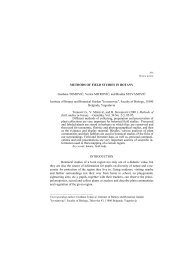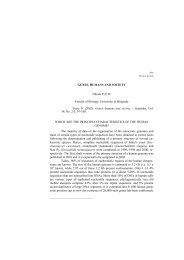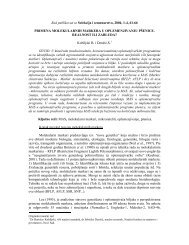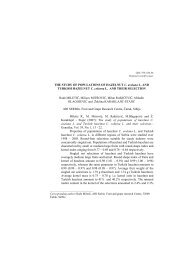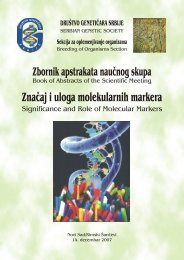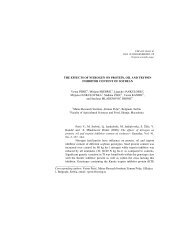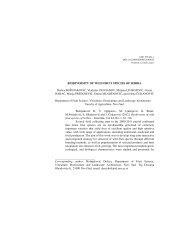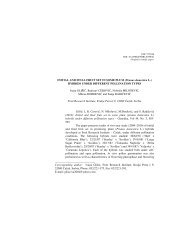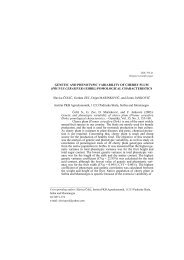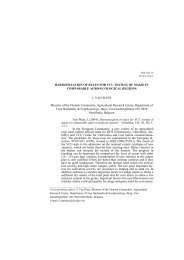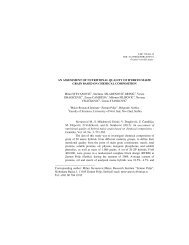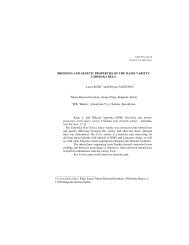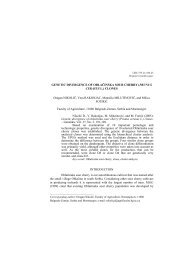Zbornik - Društvo genetičara Srbije
Zbornik - Društvo genetičara Srbije
Zbornik - Društvo genetičara Srbije
Create successful ePaper yourself
Turn your PDF publications into a flip-book with our unique Google optimized e-Paper software.
IV-Usm-18 ZBORNIK ABSTRAKATA III KONGRESA GENETIÈARA SRBIJE 107<br />
Subotica, 30. novembar - 4. decembar 2004.<br />
PROMENLJIVOST BROJA I MORFOLOGIJE HROMOZOMA I<br />
OPLEMENJIVANJE GOLOSEMENICA<br />
Mirjana Šijaèiæ-Nikoliæ, A. Tucoviæ i Dragica Vilotiæ<br />
Šumarski fakultet, Beograd<br />
Rezultati obavljenih citogenetskih analiza vrsta golosemenica, prikazuju da èetinare<br />
karakteriše evolucija na diploidnom nivou, što svedoèi o stabilnosti kariotipova i<br />
idiograma ove grupe drveæa i bunja. Kod golosemenica, prirodno visok osnovni broj<br />
hromozoma poznat je samo za tri od 359 vrsta. Golosemenice su grupe drveæa, reðe<br />
bunja sa relativno krupnim hromozomima sliènim kariotipovima i idiogramima.<br />
Osnovna panja usmerena je na unutarvrsnu citogenetsku diferencijaciju politipskih vrsta<br />
(13%) u odnosu na osnovni broj, kao znaèajnu osnovu za bru determinaciju homologih<br />
hromozoma, izradu kariotipova, idiograma i kartiranje gena u kombinaciji sa razlièitim<br />
tipovima ukrštanja odabranih individua. Uoèene specifiène unutarvrsne karakteristike<br />
(razlièiti osnovni broj hromozoma, aneuploidiji, dopunski B-hromozomi, pojedinaèna<br />
pojava poliploidije, prvenstveno na mladim oglednim biljkama) nisu unikalne jer su<br />
opisane kod veoma udaljenih rodova. Uverenje o evolucionoj stabilnosti osnovnih<br />
diploidnih brojeva hromozoma protivreèe, upravo, specifiène citogenetske karakteristike<br />
47 tzv. politipskih (polimorfnih) vrsta golosemenica.<br />
Prema evidentiranim tipovima vrsta golosemenice (monotipske i politipske po osnovnim<br />
brojevima hromozoma) karakteriše drevna (spora) evolucija hromozoma, kariotipova i<br />
idiograma, za razliku od vrsta skrivenosemenica koju karakteriše manje-više brza<br />
citogenetska evolucija. Citogenetska, kariološka i druga istraivanja rodova i vrsta<br />
osetno olakšavaju oplemenjivanje ekonomski znaèajnih vrsta golosemenica.<br />
VARIABILITY OF CHROMOSOME NUMBER AND MORPHOLOGY<br />
AND IMPROVEMENT OF GYMNOSPERMS<br />
The results of the published cytogenetic analyses of gymnosperm species show that conifers<br />
are characterised by the evolution at a diploid level, which proves the stability of<br />
karyotypes and idiograms of this tree and shrub group. In gymnosperms, the naturally<br />
high basic number of chromosomes is known only in three of 359 species. Gymnosperms<br />
are groups of trees, more rarely shrubs, with relatively large chromosomes similar to<br />
karyotypes and idiograms. The attention is focused to intraspecific cytogenetic differentiation<br />
of polytypic species (13%) compared to the basic number. This is a significant base<br />
of a faster determination of homologous chromosomes, development of karyotypes,<br />
idiograms and gene mapping in combination with different types of crossing of the selected<br />
individuals. The specific intraspecies characteristics (different basic number of<br />
chromosomes, aneuploidy, accessory B-chromosomes, individual occurrence of<br />
polyploidy, primarily in younger test plants) are not unique since they are described in<br />
very distant genera. The belief on evolution stability of the basic diploid chromosome<br />
numbers is contradicted by the specific cytogenetic characteristics of 47 so-called<br />
polytypic (polymorphic) species of gymnosperms.<br />
Based on the recorded types, gymnosperm species (monotype and polytypic by the basic<br />
numbers of chromosomes) are characterised by the ancestral (slow) evolution of chromosomes,<br />
kariotypes, idiograms, while angiosperm species are characterised by more or less<br />
fast cytogenetic evolution. The cytogenetic, karyologic and other study of genera and<br />
species support the breeding of economically significant species of gymnosperms.



